Tactical vehicular radio network comprising of multiple vehicles

Settings
- Simulation environment: 50 km * 50 km
- Application Traffic (HQ communicating with two vehicular Reece detachments)
- Situational-awareness – 79 Byte packet sent every 1s
- Data_Files – 0.5 MB file sent every 20s
- Video – 0.6 Mbps streaming video
- Type of Devices: UHF MANET Radios
- Network Layer: MANET AODV Protocol
- PHY Layer
- Transmitter Power: 20 Watts
- Receiver Sensitivity: -113 dbm
- Modulation Technique: QPSK
- Datalink Layer
- Protocol: DTDMA (Dynamic TDMA) with demand-based slot allocation
- Slot Duration: 2 ms, Frame Duration: 12 s
- Guard Interval: 100 μs
- Bits per slot: 3600 bits, Overhead per slot: 600 bits
- RF Propagation:
- Path Loss Model: Log distance
- Fading Model: Rayleigh, Shadowing Model: Log Normal
- Simulation time - 100 sec
Performance Analysis
Case 1: One vehicle transmitting data to HQ
| Application Type | Throughput (Kbps) | Latency (seconds) |
|---|---|---|
| Situational Awareness Traffic: Recce Det. Vehicle 1 to HQ |
0.013 | 0.009 |
| File Transfer Traffic: Recce Det. Vehicle 1 to HQ |
236.84 | 1.72 |
| Video Traffic: Recce Det. Vehicle 1 to HQ |
597.77 | 0.52 |
Case 2: Two vehicles transmitting data to HQ
| Application Type | Throughput (Kbps) | Latency (Seconds) |
|---|---|---|
| Situational Awareness Traffic: Recce Det. Vehicle 1 to HQ |
0.013 | 0.012 |
| File Transfer Traffic: Recce Det. Vehicle 1 to HQ |
236.84 | 2.18 |
| Video Traffic: Recce Det. Vehicle 1 to HQ |
597.38 | 1.45 |
| Situational Awareness Traffic: Recce Det. Vehicle 2 to HQ |
0.013 | 0.71 |
| File Transfer Traffic: Recce Det. Vehicle 2 to HQ |
250.00 | 2.73 |
| Video Traffic: Recce Det. Vehicle 2 to HQ |
575.51 | 1.98 |
Throughput vs time plot (FTP Application)
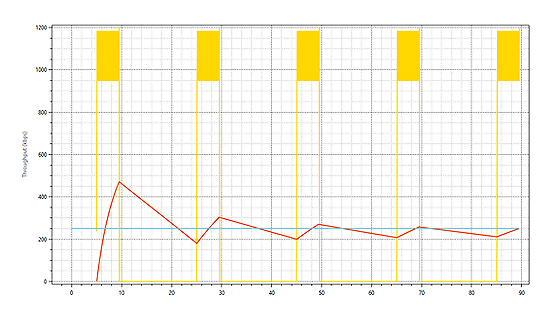
Throughput vs time plot (Application - FTP_1)
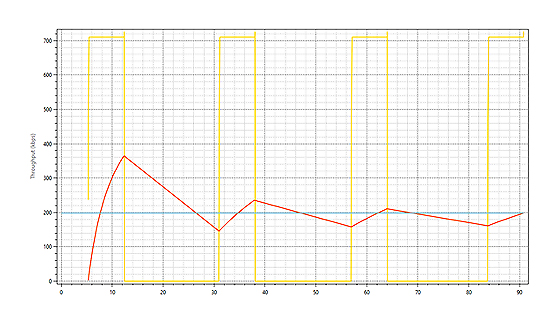
Throughput vs time plot (Application - FTP_2)
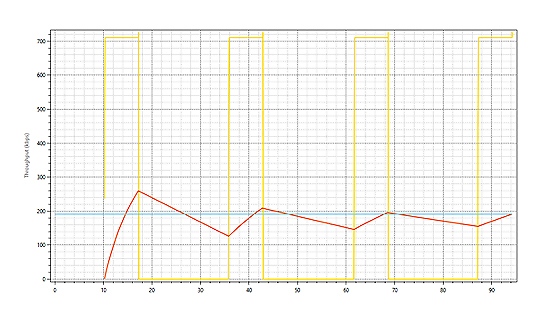
Throughput vs time plot (Video Application)

Throughput vs time plot (Application - Video_1)
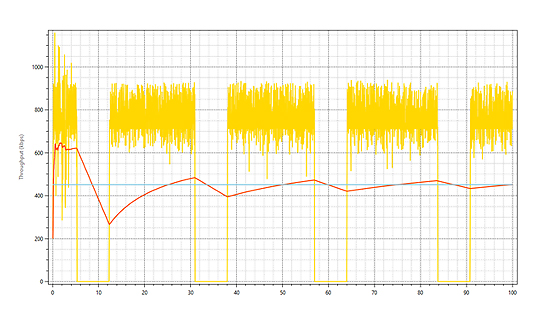
Throughput vs time plot (Application - Video_2)
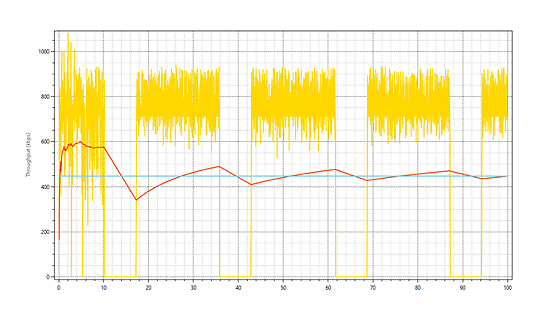
Throughput vs Time Plot (Link)

Throughput vs Time Plot (Link)

Conclusions - Case 1
The start time for FILE_RECEE is 5s. In the Throughput vs Time plot for the FILE_RECEE application, the file transmission starts at the 5th second, achieving a throughput of approximately 1.1 Mbps. The file size is 562500 B (4.5 Megabits). With a throughput of 1.1 Mbps, it takes about 4.5s to transfer. Therefore, the throughput drops around 9.5s as the file transfer is completed. The file inter-arrival time is 20s, meaning the next (2nd) file is generated and transmitted at the 25th second (5s + 20s). At the 25th second, transmission starts again, takes around 4.5s, and completes by 29.5s. This cycle repeats.
Now, consider the Throughput vs Time plot for the Video application. This application starts at 0s with a throughput of about 600 Kbps, matching the generation rate. This indicates that the network has sufficient capacity to transmit the video. When the FTP application starts at 5s, it gets transmission priority, causing the video throughput to drop to 0. Once the FTP transmission completes at 10s, video transmission resumes. The throughput increases to about 1.2 Mbps as buffered video frames are sent. By the 18th second, all buffered frames are transmitted, and the video throughput returns to 600 Kbps, matching the generation rate.
The link which has a capacity of 1.5 Mbps initially sees about 600 Kbps of occupancy. Once the FTP application starts, the link occupancy goes up to 1.2 Mbps. After the file is transferred in the FTP application, the link occupancy starts reducing since it is only video that is now being transmitted.
Conclusions - Case 2
We compare two scenarios: simultaneous transmission by two vehicles (case 2) and transmission by a single vehicle (case 1). At 0s, both vehicles start video transmissions. In case 1, the video transmission throughput is approximately 600 Kbps. In case 2, each video initially gets 600 Kbps, resulting in a total system throughput of 1.2 Mbps. This is possible because the link's PHY capacity is 1.5 Mbps.
Now the FILE_RECEE_1 starts at 5s, while the FILE_RECEE_2 starts at 10s. Each application sends a 4.5 Megabit file every 20s, resulting in an average FTP generation rate of 225 Kbps. As soon as FILE_RECEE_1 starts in Vehicle 1, it is given priority over the video transmission from the same vehicle. Therefore, the throughput of Video_1 drops immediately. Note that in case 1, FTP application saw an instantaneous throughput of about 1.1 Mbps whereas in case 2, it is only able to get a throughput of ~ 710 Kbps. This is because some of the slots on the link is being allocated to Video_2 application. Therefore the 4.5 Mbit file takes ~ 6.3s to transfer, as opposed to 4.5s in case 1. This in turn means that the video_1 application will start getting transmitted (after being buffered) only from around 11.3 s (5s + 6.3s). In case 1 the video started getting transmitted from 9.5s itself.
Next, let us study the application throughputs for the transmissions from the second vehicle. Similar to the first vehicle video starts at 0s and sees a throughput of 600 Kbps till 5s. At this time FTP_1 starts, and this leads to a slight drop in Video_2, since the DTDMA protocol starts assigning more slots to FTP_1 application. FTP_2 starts from 10s. At this point in time, FTP_2 gets higher priority over Video_2 (since both are being transmitted from the same vehicle). Therefore, the throughput of video_2 drops to zero. Similar to FTP_1, FTP_2 also see a throughput of ~ 710 Kbps, and hence it also takes ~ 6.3s to transfer each file. Once this file is transmitted, Video_2 again starts seeing a throughput of ~ 750 Kbps.
The Video application throughput of 750 Mbps in between the file transfers. This is because of video packets getting buffered. Video is being continuously generated at 600 Kbps, but there is packet buffering during the time when the FTP application is being sent. This cycle repeats.
As compared to case 1, where the link was not fully occupied, in case 2, we see the link is fully utilized and the link throughput is at 1.5 Mbps. In fact, the combined generation rate of the 2 FTP and 2 Video application is greater than 1.5 Mbps. It is for this reason that the situational awareness application sees a latency of 9.3 s as against 8.78 ms!